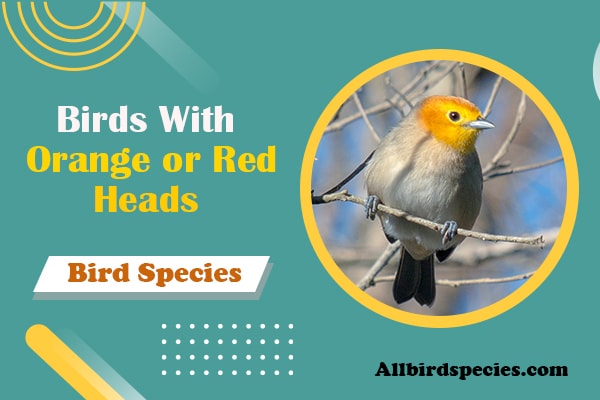11 Stunning Birds With Orange Heads (With Pictures)
Did you know only about 10% of birds have bright orange heads? Seeing these birds is exciting for birdwatchers and nature lovers. This guide will take you into the world of these colourful birds.
Their bright orange dazzles our eyes and plays a big role in their lives. Knowing why they are so rare makes us appreciate wildlife more. Let’s explore 11 amazing birds with orange heads together.
Understanding Bird Coloration and Its Purposes
Colour plays a big role in a bird’s life. It helps them survive and find a mate. The colours on their feathers tell us how they fit into their world.
The Role of Color in Survival
Some birds have bright colours because colour helps them hide from predators and shows off their health to potential mates.
Common Color Mechanisms in Birds
There are two main ways birds get their colors. One is from what they eat, like carotenoids. The other is from how their feathers reflect light. This is why some colors, like orange, are rare in birds.
| Color Mechanism | Source | Examples |
|---|---|---|
| pigmentation | Diet (e.g., carotenoids) | Goldfinch, Flamingo |
| Structural coloration | Feather microstructure | Blue Jay, Peacock |
| Combination | Diet + Microstructure | Mandarin Duck, Cardinal |
Overview of Stunning Birds With Orange Heads
Birds with orange heads are a treat for birdwatchers of all levels. Their bright color grabs everyone’s attention. This color helps them find mates and show off to others.
These birds are a big deal in nature. Their bright orange makes them stand out, and spotting them is an exciting adventure.
Why Orange Heads Stand Out
Birds with orange heads have a special look. They are rare and unique, making them a big hit among birdwatchers. Each species has its own orange pattern.
Exploring these birds reveals their special qualities. We learn to appreciate their beauty and role in nature.
1. Western Tanager
- Scientific Name: Piranga ludoviciana
- Size: 18–20 cm (7–8 in)
- Weight: 20–30 g (0.7–1.1 oz)
- Lifespan: Up to 10 years
- Diet: Insects, fruits, seeds
The Western Tanager, known as Piranga ludoviciana, is a favorite among birdwatchers. It is brightly colored and has striking features. Its bright orange-red head and chest make it a joy to see in nature. Knowing how to spot this bird can make birdwatching even better.
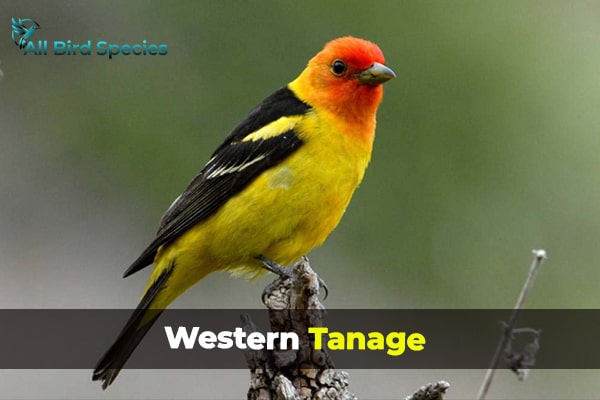
Description and Identification Features
The Western Tanager is easy to spot. Males have bright yellow feathers in the breeding season. Females have less bright yellow-brown feathers. Key features include:
- Bright orange-red head and chest for males
- Less vibrant yellow-brown colouration for females
- Pale beak, which is quite noticeable
- Distinct wing bars that provide easy recognition
Habitat and Migration Patterns
The Western Tanager lives in many places like forests and orchards. You can see them in these areas when it’s warm. Their migration is also interesting. They go from the western U.S. and Canada to Mexico and Central America for winter.
2. Rufous Hummingbird
- Scientific Name: Selasphorus rufus
- Size: 7.5–9 cm (3–3.5 in)
- Weight: 2.0–4.0 g (0.07–0.14 oz)
- Lifespan: Up to 9 years
- Diet: Nectar, insects, spiders
The Rufous Hummingbird, or Selasphorus rufus, is a favorite among bird watchers. It has bright colors and unique features. Here are some key traits to help you identify them.

Identifying Characteristics
This small bird has a bright orange-rufous head and a shiny throat. The male’s colours are bold, while the females are more subtle. It has a long beak for reaching nectar in flowers. It is about 3 inches long, making it easy to spot.
Diet and Breeding Grounds
The Rufous Hummingbird eats nectar mostly for energy. It also eats insects and spiders for protein. Knowing their diet helps us understand their importance as pollinators.
They breed in southeastern Alaska and the northwestern United States. During the breeding season, they can be found in gardens and forests and make their homes there.
| Characteristic | Description |
|---|---|
| Scientific Name | Selasphorus rufus |
| Colouration | Orange-rufous head with iridescent throat |
| Size | Approx. 3 inches in length |
| Diet | Nectar, insects, and spiders |
| Breeding Range | Southeastern Alaska to northwestern USA |
| Habitat | Forests and gardens |
3. Streak-backed Oriole
- Scientific Name: Icterus pustulatus
- Size: 22–25 cm (8.7–9.8 in)
- Weight: 40–50 g (1.4–1.8 oz)
- Lifespan: Up to 10 years
- Diet: Fruits, insects, nectar
The Streak-backed Oriole, known as Icterus pustulatus, is a bird that catches the eye. It has a bright orange head and a black face mask. Knowing how to spot these features can help you identify birds better.
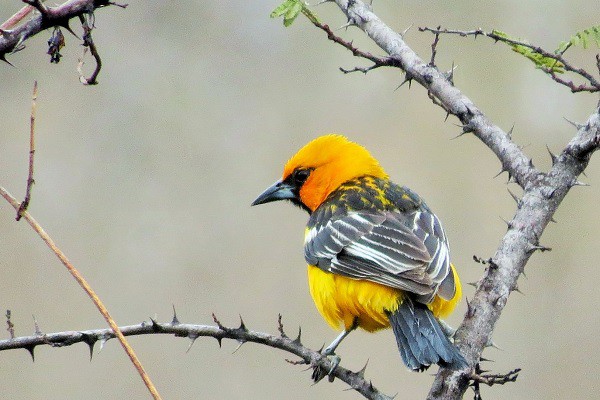
Physical Appearance
Males have brighter colors, like a yellow belly and dark streaks on their back, while females are less colorful. Both have white bands on their wings, which makes them look great. They are about 8 to 9 inches long, which makes them stand out.
Preferred Habitats
Streak-backed Orioles live in many places. They like tropical woodlands, plantations, and even cities with many trees. They eat insects, fruits, and nectar. This diet helps them and pollinates plants. Knowing where they live helps us see their importance in nature.
| Feature | Description |
|---|---|
| Scientific Name | Icterus pustulatus |
| Length | 8-9 inches |
| Coloration | Bright orange head, black face mask, yellow underbelly |
| Habitat | Tropical woodlands, plantations, urban areas |
| Diet | Insects, fruits, nectar |
4. Ruddy Kingfisher
- Scientific Name: Halcyon coromanda
- Size: 28–30 cm (11–12 in)
- Weight: 100–150 g (3.5–5.3 oz)
- Lifespan: Up to 10 years
- Diet: Fish, crustaceans, amphibians
The Ruddy Kingfisher, known as Halcyon coromanda, is a birdwatcher’s dream. It has a dark orange head and a bright blue back. This makes it stand out in forests and near water.

Its large red beak is another key feature. It helps spot this bird in its natural setting.
Distinctive Features
The Ruddy Kingfisher has many unique features. These include:
- Dark orange head that commands attention
- Bright blue back provides a stunning visual contrast
- Large red beak, ideal for catching prey
Feeding Habits
The Ruddy Kingfisher eats fish, insects, and amphibians. It hunts by perching over water, waiting for prey. Its hunting skills are impressive.
5. Flame-colored Tanager
- Scientific Name: Piranga bidentata
- Size: 17–19 cm (6.7–7.5 in)
- Weight: 20–30 g (0.7–1.1 oz)
- Lifespan: Up to 10 years
- Diet: Fruits, insects
The Flame-colored Tanager, known as Piranga bidentate, is a vibrant bird that catches the eye of birdwatchers and enthusiasts. Its bright orange and yellow colors are a joy to see in nature.

When spotting this bird, look for certain features. These make it easier to recognize the Flame-colored Tanager.
Identification Tips
Here are some tips to help you identify this bird:
- Bright orange head and underparts with yellowish tones on the belly.
- Distinctive black wings and tail with white wing bars.
- Medium-sized, about 6 to 7 inches long.
- The sharply graduated tail helps in quick flight, darting between branches.
Localized Distribution
The Flame-colored Tanager is found mainly in Mexico and Central America, but it is sometimes seen in southern Arizona. It lives in various habitats, making it flexible.
Some favourite places include:
- Dappled evergreen forests, where they blend in and find food.
- Coffee plantations offer food and protection from predators.
6. Orange-headed Thrush
- Scientific Name: Geokichla citrina
- Size: 25–27 cm (9.8–10.6 in)
- Weight: 60–100 g (2.1–3.5 oz)
- Lifespan: Up to 5 years
- Diet: Fruits, insects, worms
The Orange-headed Thrush, or Geokichla citrina, is a bird with bright features. It has a vibrant orange head and belly. This makes it stand out with its grey upper parts.
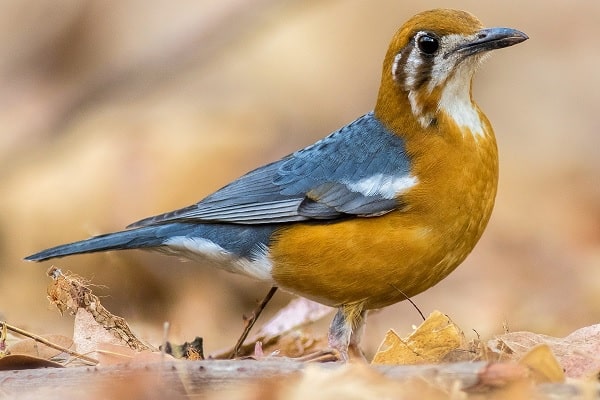
Seeing these birds is rewarding. It’s especially fun to spot the differences in their feathers between males and females.
Physical Description
Males have a brighter orange colour. This makes their heads and bellies really pop. Females are still beautiful but a bit paler.
Important features of the Orange-headed Thrush include:
- Vivid orange crown and throat
- Grayish-brown wings and back
- Soft, pale underparts with a warm orange tone
- Distinctive dark facial markings that add to its charm
Knowing how males and females look helps in birdwatching. Their bright colours make them beautiful in their natural homes.
| Feature | Male | Female |
|---|---|---|
| Head Color | Vibrant Orange | Paler Orange |
| Body Color | Grayish-brown | Grayish-brown |
| Facial Markings | Distinct Dark Markings | Less Defined Markings |
7. Yellow-billed Kingfisher
- Scientific Name: Halcyon coromanda
- Size: 25–28 cm (9.8–11 in)
- Weight: 50–70 g (1.8–2.5 oz)
- Lifespan: Up to 10 years
- Diet: Fish, insects, small reptiles
The Yellow-billed Kingfisher, known as Syma toro toro, is a bird that catches the eye. It has an orange head and a yellow-orange beak, and its feathers are a mix of blue and green, making it fun to spot.
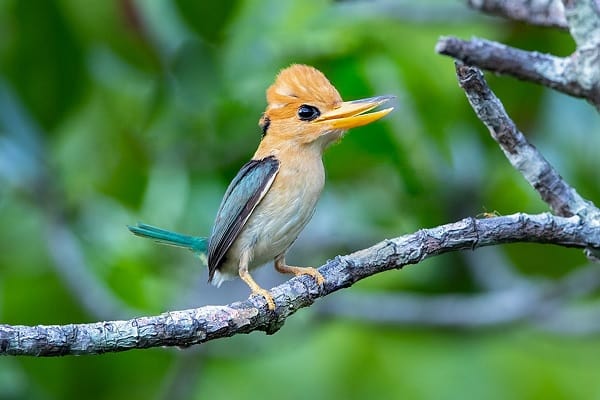
It has a round body and a long, sharp beak. These help it catch fish and insects in the water.
Identification Characteristics
Looking at the Yellow-billed Kingfisher, you’ll see some key traits:
- Vivid orange head that grabs attention.
- Yellow-orange beaks are distinctively shaped for hunting.
- Underparts that vary from cream to blue, depending on the individual.
- Size ranges from 24 to 27 centimeters in length.
Habitat Preferences
This bird loves lush places. It thrives in:
- Rainforests, where it finds plenty of food.
- Mangroves that offer shelter and nesting spots.
- Shrublands across New Guinea and parts of Australia.
The Yellow-billed Kingfisher’s home is key to its survival. It affects how it eats and breeds. Protecting its habitat is vital for its survival.
8. Orange-headed Tanager
- Scientific Name: Thraupis cana
- Size: 18–20 cm (7–8 in)
- Weight: 25–35 g (0.9–1.2 oz)
- Lifespan: Up to 10 years
- Diet: Fruits, seeds, insects
The Orange-headed Tanager is known for its bright colors, which change depending on where it lives in South America. These colors help the bird survive and find a mate.

Color Variations
Each group of Orange-headed Tanagers has its own colors. These colors depend on the climate and food in their area. They help the birds hide or find a mate. Here’s a table showing some subspecies and their colors:
| Subspecies | Primary Coloration | Geographical Distribution | Habitat Type |
|---|---|---|---|
| Spixii | Bright orange head with green body | Brazil | Tropical rainforests |
| Caniveti | Reddish-orange head with blue-green wings | Colombia | Cloud forests |
| Metals | Deep orange head with dark green back | Bolivia | Wooded areas near water sources |
9. Japanese Robin
- Scientific Name: Larvivora akahige
- Size: 14–15 cm (5.5–5.9 in)
- Weight: 15–20 g (0.53–0.71 oz)
- Lifespan: Up to 5 years
- Diet: Insects, berries
The Japanese Robin, known as Larvivora akahige, has amazing migratory habits. It has a bright orange head and sings beautiful songs. Its journey takes it from Japan to Southeast Asia.

Migratory Patterns
In summer, the Japanese Robin loves Japan’s gardens and forests. But when winter comes, it migrates to warmer places in Southeast Asia. This journey is crucial for its survival and for the balance of nature.
Knowing where the Japanese Robin goes helps us protect its home. It tells us when and where to see this lovely bird. Here’s a quick look at its migration:
| Season | Location |
|---|---|
| Summer | Japan |
| Winter | Southeast Asia |
10. Scarlet-headed Blackbird
- Scientific Name: Cacicus scintillans
- Size: 25–30 cm (9.8–11.8 in)
- Weight: 70–100 g (2.5–3.5 oz)
- Lifespan: Up to 10 years
- Diet: Insects, fruits, nectar
The Scarlet-headed Blackbird, Amblyramphus holosericeus, is found in southeastern South America’s wetlands. It has a bright orange head and a black body. These physical traits help you spot it in nature.
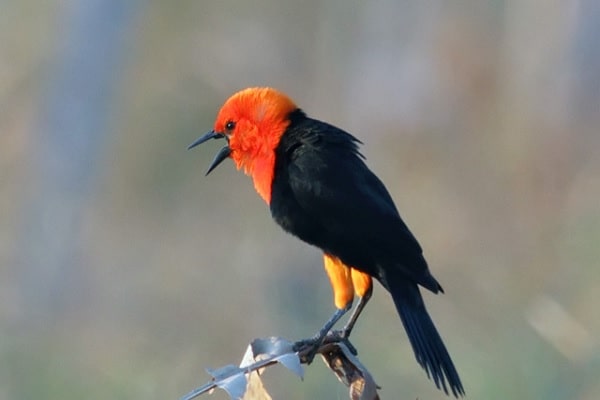
It’s vibrant throat and thigh colours add to its beauty. These colors help in recognizing the bird.
Identifying Features
Look closely at the Scarlet-headed Blackbird’s key features. Here’s what to notice:
- Bright orange head that stands out against its dark body.
- Black wings and tail feathers.
- White wing patches that show when it flies.
- Unique throat and leg colors vary among birds.
Habitat and Feeding
Knowing where the Scarlet-headed Blackbird lives helps you find it. It likes marshes and grasslands near water. Its diet includes insects, frogs, and seeds found in its habitat.
It searches for food along pond edges and in tall grass. This shows how it meets its dietary needs.
| Feature | Description |
|---|---|
| Scientific Name | Amblyramphus holosericeus |
| Coloration | Orange head, black body, white wing patches |
| Habitat | Vegetated marshes and grasslands in southeastern South America |
| Diet | Insects, frogs, seeds |
Final Word
Birds with orange heads are truly amazing. They are not just beautiful but also very important in their homes. Like the Western Tanager, each bird shows how different nature can be.
Their bright colors help them find friends and mark their places, making them very interesting to watch. You’ll find these birds with orange heads very special if you love birds.
Knowing about these species is key for those who love to watch birds. It makes your time outside even better. Look for the Rufous Hummingbird or the Scarlet-headed Blackbird on your next trip.
Watching these birds can make you love nature more. So, get your binoculars ready and go outside. You’ll see the beauty of these birds and learn a lot about our world.
Read More🐦Related Articles:
| White Birds in Florida with Long Beaks |
| Orange Butterfly Meaning |
| Finches in Michigan |
| inches In Hawaii |
Frequently Asked Questions
Q1: What is the name of the bird with an orange head?
Depending on the species, the bird with an orange head could be the Northern Cardinal, Baltimore Oriole, or Northern Flicker.
Q2: What is the orange-colored bird in India?
One notable orange-colored bird in India is the Indian Pitta, which has vibrant orange and green plumage.
Q3: What kind of bird is orange-headed in Mexico?
The Orange-fronted Parakeet is a bird in Mexico with an orange head.
Q4: What bird has an orange throat?
The Bullock’s Oriole is a bird with an orange throat, found in North America.

